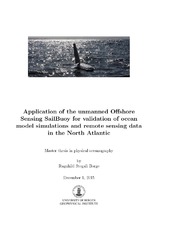Application of the unmanned Offshore Sensing SailBuoy for validation of ocean model simulations and remote sensing data in the North Atlantic
Master thesis
Permanent lenke
https://hdl.handle.net/1956/10972Utgivelsesdato
2015-12-01Metadata
Vis full innførselSamlinger
- Geophysical Institute [1198]
Sammendrag
The Offshore Sensing SailBuoy, is a remotely controlled, wind driven unmanned ocean vehicle. It sampled near surface properties during a mission in the North Atlantic in June - August 2014. Three parameters were recorded, sea surface temperature, conductivity and dissolved oxygen concentration. The observed near surface properties are compared with ocean model output and remote sensing data. The mean error of sea surface temperature data from remote sensing and ocean models compared with near surface measurements from the SailBuoy are approximately 0.5°C. For sea surface salinity, the mean error from ocean model outputs compared with sea surface salinity calculated from the conductivity measured by the SailBuoy, are approximately 0.3 psu. The SailBuoy can measure salinity near the coast, where remote sensing data are not available. It has the capacity to be a cost- and time saving alternative to larger research vessels, as well as for validation of ocean model simulations and remote sensing data.
